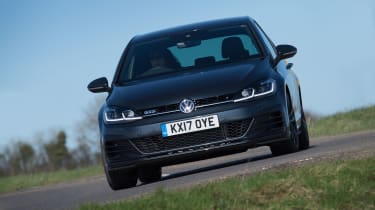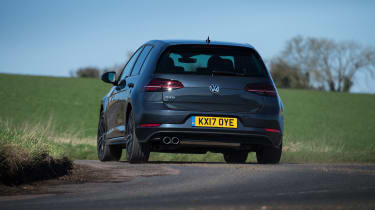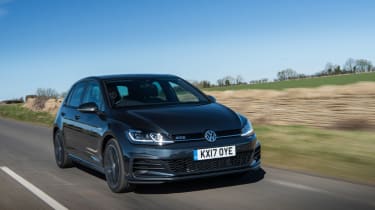Volkswagen Mk7 Golf GTD (2014-2020) review – ride and handling
Frugal and refined but at the cost of excitement
The GTD boasts stiffer suspension than a regular Golf and a 15mm lower ride height. To increase the GTD’s breadth of ability it can be equipped with VW’s Dynamic Chassis Control (DCC) active dampers, which offer three settings: Sport, Comfort and Normal.
It's supposedly a little softer than the GTI, but with the DCC set to Sport the chassis exhibits the same precision and agility as its petrol-powered cousin. The softer options, Comfort and Normal, feel more luxurious and suit the car’s more relaxed disposition and its solid, quality interior.
Front-end grip is impressive for what it is, though, and turns in with the verve and spirit you’d expect from a menial hot hatch. Then, from mid-corner to exit, it’s always composed; there’s a degree of roll but it’s well contained and the body remains controlled no matter what.
The front tyres are aided in dealing with the GTD’s comparatively large amount of torque with Volkswagen's XDS+, an electronic limited-slip differential-cum-torque vectoring system. It brakes an inside front wheel to stop it losing grip while also forcing the open differential to send torque to the outside wheel. The system also brakes an inside wheel on the rear axle too, helping the GTD maintain your desired line even at significant speeds.
More reviews
Impressive then, and the GTD’s abilities are just as commendable as those of the proper GTI. But, just like the GTI, these impressive levels of grip and control limit the fun you can have behind the wheel. Even with the traction and stability control turned off as much as possible (a degree of electronic interference remains no matter what you press or for how long), there’s very little in the way of adjustability or access to the car’s limits of grip. In fact, the poor engine braking of the GTD’s engine (when compared to the GTI) means that occasional, entertaining lift-off oversteer is even less a part of the car’s repertoire.
The lack of retardation from the engine and an extra 31kg of mass means that, despite the GTD having the same brakes a standard GTI, they don’t seem to have the same bite or force as the ones on the petrol-powered hatch. However, it should be said that the GTD’s brakes easily cope with the demands of road driving, no matter how hard the car is being driven.
The GTD is a well-rounded, quality-feeling car with decent performance and more than respectable handling. But it doesn’t match the GTI for fun, nor performance, and that’s not even one of our favourite hot hatches.





